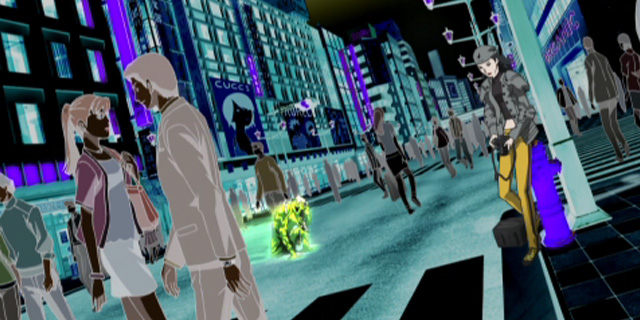
When Persona 2 originally made it stateside in 2000, most fans were unaware that they had only received half of a complete story. The game’s first half, Innocent Sin, would only be released in Japan, leaving a gap that wouldn’t be filled until 11 years later. Atlus has heard the call, and with the US release of Innocent Sin’s PSP remake, fans can finally visit the missing half of Persona 2’s narrative, along with a redone soundtrack by Shoji Meguro and a new, stylized interface.
Gameplay is standard-issue Shin Megami Tensei fare. Players dungeon-crawl their way through the game while fighting it up in random encounters, though as usual, dungeons in Persona titles aren’t your typical caverns or dimly lit tunnels, but schools, abandoned buildings and malls. One of the game’s key features is the rumor system. In Innocent Sin, rumors spread among the populace turn to reality, turning regular fast-food places into black-market weapon shops. Rumors are customizable, as you can hear variations of one rumor from different sources or turn locations into gambling centers, mix and match them as you see fit, then spread a final rumor to be turned to reality. You could, for instance, make the weapon shop sell high-quality goods for cheap, or sell expensive but poorly-crafted junk.
It’s clear that Persona 2 is an entirely different beast from Persona 3 and 4, the two games that made the series popular. While 3 and 4 take many steps to differentiate the Persona spin-offs and give the player much more freedom, Persona 2 is much more comparable to the main Shin Megami Tensei titles, and is largely unchanged from the 1999 original. You don’t get new Persona by easily picking out magical floating cards at the end of battles. Instead, you negotiate with demons to obtain tarot cards which are used to obtain them. The battle encounter rate is unforgiving, and even with the game’s auto-battle feature, be prepared to turn off spell effects and the like if you don’t want battles lasting overly long. The game was clearly aimed at the old-school SMT fan, and the fans wouldn’t have it any other way.
The narrative takes a bit to get going, but once it does, it really gets going. Outside of some minor changes regarding a certain German Führer and his army, the story and its elements have remained intact, and Atlus changed nothing for the English localization, even when minor quirks like character Lisa Silverman’s random Cantonese phrases. It is often a bit jarring to heart the demons speak Japanese while the playable characters speak English, but it’s something you get quickly get used to.
It takes a lot of guts to basically re-release a PS1 game to the current RPG generation, but you got to give points to Atlus for giving the fans what they want and even consider localizing Innocent Sin in the troubled US PSP market. Between this, the updated release of Persona 4 for the Vita, the announcement of a new Persona and the newly announced fighting game, series fans can’t complain about how well Atlus treats their fanbase. Innocent Sin’s interface changes are a warm welcome, yet everything feels like the team at Atlus simply knows their clientele.
Pros: Largely-preserved gameplay from the original
Cons: Dated, less-forgiving elements for newcomers



















